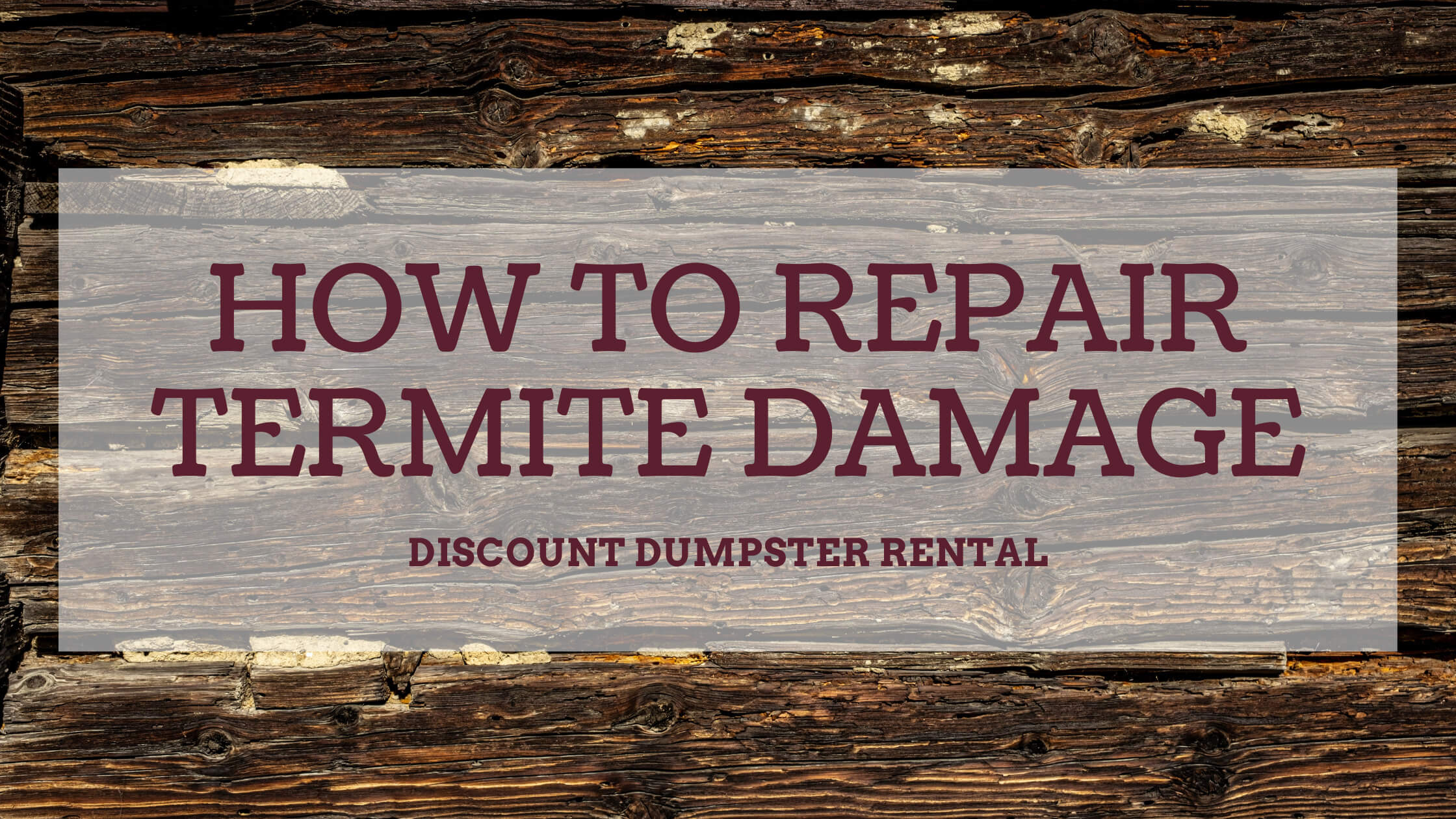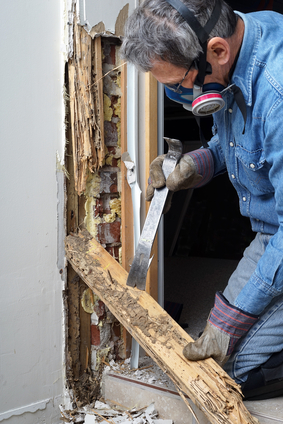
How Do You Fix Termite Damage
To fix termite damage, you can either replace the damaged sections of wood entirely or add a wood support adjacent to the damaged wood. However, it is best to consult with a professional for termite damage repair, especially if the colony is mature.
Termites can cause extensive and unresolved structural damage to a home if left untreated for many years. It is important to identify and repair termite damage as soon as possible to prevent further deterioration.

Credit: www.arrowtermiteandpestcontrol.com
Understanding Termite Damage
To fix termite damage, you have two options: either replace the damaged sections of wood entirely or add wood support adjacent to the damaged area. It’s always recommended to seek professional help for termite damage repair, especially when the colony is mature.
Impact Of Termite Damage On Wood
Termites can cause significant damage to wooden structures, compromising their integrity and stability. The impact of termite damage on wood is extensive and can vary depending on the severity of the infestation. These tiny pests feast on the cellulose present in wood, gradually hollowing it out from the inside. As a result, the affected wood becomes weak, brittle, and structurally unsound. If left untreated, termite damage can lead to costly repairs and even pose safety hazards. It is crucial to identify and address termite damage promptly to prevent further deterioration.Signs And Symptoms Of Termite Infestation
Detecting termite infestation early is essential to minimize the damage caused. Here are some common signs and symptoms that indicate the presence of termites:- Wood damage: Look out for hollowed or damaged wood, especially in areas near the ground.
- Piles of frass: Termites leave behind droppings called frass. It resembles small pellets and can be found near termite tunnels or holes.
- Mud tubes: Termites build mud tubes to provide moisture while traveling. These tubes can be found on walls, foundation, or other wooden surfaces.
- Discarded wings: Termites shed their wings after swarming. If you notice discarded wings near windows or light sources, it may indicate a termite infestation.
- Clicking or rustling sounds: Some termite species make audible noises when they are disturbed. Listen for unusual sounds coming from walls or wooden structures.
Importance Of Addressing Termite Damage Promptly
Addressing termite damage promptly is crucial to mitigate further destruction and safeguard your property. Here’s why addressing termite damage promptly is essential:- Prevent structural damage: Termites can weaken the structural integrity of your home by damaging load-bearing walls and wooden supports. Timely repairs can prevent collapses and expensive reconstruction.
- Protect investment: Your home is likely one of your most significant investments. Addressing termite damage promptly helps preserve its value and prevents long-term depreciation.
- Minimize health risks: Termites thrive in humid environments and may contribute to mold growth. This can lead to respiratory issues and allergies. Repairing termite damage ensures a healthy living environment.
- Prevent infestation spread: Addressing termite damage quickly helps prevent the infestation from spreading to other areas of your home, minimizing the scope of repairs.
- Avoid financial setbacks: Delaying termite damage repairs can result in mounting costs over time. Prompt action can save you from significant financial setbacks.
Repairing Termite Damage
Termite damage to wood can be a major concern for homeowners. Fortunately, there are effective ways to repair and restore the damaged areas. In this section, we will discuss the key steps involved in repairing termite damage. From replacing damaged wood to adding wood support, using wood hardeners and fillers, to seeking professional assistance, we will cover it all. Let’s dive in!
Replacing Damaged Wood
When dealing with termite damage, it’s essential to assess the extent of the damage before proceeding with repairs. Start by identifying the areas where wood has been significantly damaged. Once you have identified the damaged sections, the next step is to remove them entirely. This involves cutting out the damaged wood and ensuring that the surrounding area is clean and free from any remaining traces of termites.
Once the damaged sections have been removed, it’s important to select suitable replacement wood. Look for wood that matches the type and size of the existing structure, ensuring it provides the necessary strength and durability. Proper installation techniques should be implemented to ensure a seamless integration of the new wood with the existing structure.
Adding Wood Support
Assessing the structural stability of the affected areas is crucial in repairing termite damage. It’s important to identify areas that require additional support to restore the structural integrity of the wood. This may involve adding wood supports adjacent to the damaged sections.
Choosing appropriate support materials is essential to ensure long-lasting stability. Materials such as treated lumber or engineered wood products can be used to provide the necessary strength and support. Proper installation methods should be followed to ensure a secure and stable addition of support to the damaged wood.
Wood Hardeners And Fillers
For minor termite damage and discoloration, wood hardeners and fillers can be effective in restoring the wood’s appearance and strength. Before applying any treatments, it’s important to evaluate the extent of the damage and prepare the affected area properly.
Selecting the appropriate wood hardeners or fillers is essential to ensure compatibility with the type of wood and the specific damage. Application techniques for filling gaps and repairing minor damage should be followed carefully to achieve optimal results.
Professional Termite Damage Repair
While DIY repairs can be effective for minor damage, it’s crucial to seek professional assistance when dealing with extensive termite damage. Professional termite damage repair services offer several benefits, including expertise in identifying and addressing hidden damage, using specialized tools and techniques, and providing long-term solutions to prevent future infestations.
When hiring a professional for termite damage repair, it’s important to choose a reputable and experienced contractor. Research their qualifications, read reviews, and ask for references to ensure you’re working with a reliable professional. During the repair process, expect a thorough assessment of the damage, efficient and effective repair techniques, and guidance on preventive measures to protect your home from future termite infestations.
Prevention And Maintenance
When it comes to protecting your home from termite damage, prevention and regular maintenance are key. By taking proactive measures, you can significantly reduce the risk of infestation and ensure the long-term health of your property.
Regular Termite Inspections
Regular termite inspections play a crucial role in preventing termite damage. These inspections, conducted by trained professionals, help identify any signs of termite activity before it becomes a major problem. By performing regular inspections, you can catch termite infestations early on and take immediate action to eliminate them.
The frequency of termite inspections may vary depending on your location and the level of termite activity in your area. In general, it is recommended to have a professional inspection at least once a year. However, if you live in an area with high termite activity, more frequent inspections may be necessary.
During a termite inspection, the professional will carefully examine your property for any potential entry points or signs of termite activity. This includes checking foundation walls, crawl spaces, and wooden structures for visible damage or mud tubes. By identifying these potential entry points, you can take proactive measures to reinforce or seal these areas, making it harder for termites to gain access to your home.
Taking proactive measures to prevent termite infestation is crucial in maintaining the integrity of your home. This includes eliminating any wood-to-soil contact, keeping firewood and other wooden materials away from your home’s foundation, and maintaining proper drainage to prevent moisture buildup. By addressing these potential risk factors, you can reduce the likelihood of termite infestation and minimize the potential damage they can cause.
Termite Treatment Methods
If you already have termite damage in your home, it is crucial to address the issue promptly. There are different types of termite treatments available, depending on the severity of the infestation and the type of termites involved.
One common treatment method is the use of liquid termiticides, which are applied around the perimeter of your home to create a barrier that repels termites. Another option is termite baits, which are strategically placed around your property to attract termites and eliminate the colony.
When choosing a termite treatment option, it is important to consult with a professional pest control company. They will assess the extent of the infestation and recommend the most suitable treatment method for your specific situation.
Regular follow-up treatments are essential to ensure long-term prevention. These treatments may involve the reapplication of termiticides or the monitoring of termite baits to maintain their effectiveness. By scheduling regular follow-up treatments, you can protect your home against future termite infestations and minimize the risk of further damage.
Frequently Asked Questions Of How Do You Fix Termite Damage
How Do You Repair Wood After Termite Damage?
To repair wood after termite damage, you have two main options. You can either replace the damaged sections entirely or add a wood support adjacent to the damaged wood. If the damage is minimal, you can use wood hardeners or fillers to fill in the gaps.
It is best to consult a professional for termite damage repair, especially if the infestation is extensive. Termite damage can be difficult to fully assess and repair without the proper knowledge and expertise. A professional can thoroughly inspect the extent of the damage and recommend the appropriate repairs to address any structural issues caused by termites. Additionally, they can also provide advice on termite control methods to prevent future infestations and protect your property. Taking the time to consult a professional can ultimately save you time and money in the long run by ensuring that the repairs are done correctly and that your property is properly protected against termites.
Is Your House Ruined If You Have Termites?
Termites can ruin your house if left untreated for many years. However, it is rare for them to cause irreparable damage. Professional termite treatment and repairs can fix the damage caused by termites. It’s important to address the infestation promptly to prevent further harm to your home.
Is Termite Damage A Deal Breaker?
Termite damage is not necessarily a deal breaker when buying a home, unless there is an active and unresolved termite infestation or extensive structural damage caused by termites. In most cases, termite damage can be repaired or replaced, depending on the extent of the damage.
It is best to consult a professional for proper treatment and repairs.
What To Do With Termite Infested Wood?
To fix termite-infested wood, there are two main options: replace the damaged sections entirely or add a wood support adjacent to the damaged wood. Calling your local building services or building inspection department for guidance on disposal is recommended. Termite-damaged wood is typically disposed of at waste management sites.
It is best to consult a professional for termite damage repairs, especially when the infestation is severe.
Conclusion
Fixing termite damage requires careful consideration and professional expertise. By replacing damaged sections of wood or adding wood support adjacent to the affected area, you can effectively repair termite damage. It is important to address termite damage promptly to prevent further structural issues.
Seeking the assistance of a professional is highly recommended to ensure proper repair and long-term prevention of termite infestations. Remember, prevention is key to avoiding extensive termite damage in the future.

